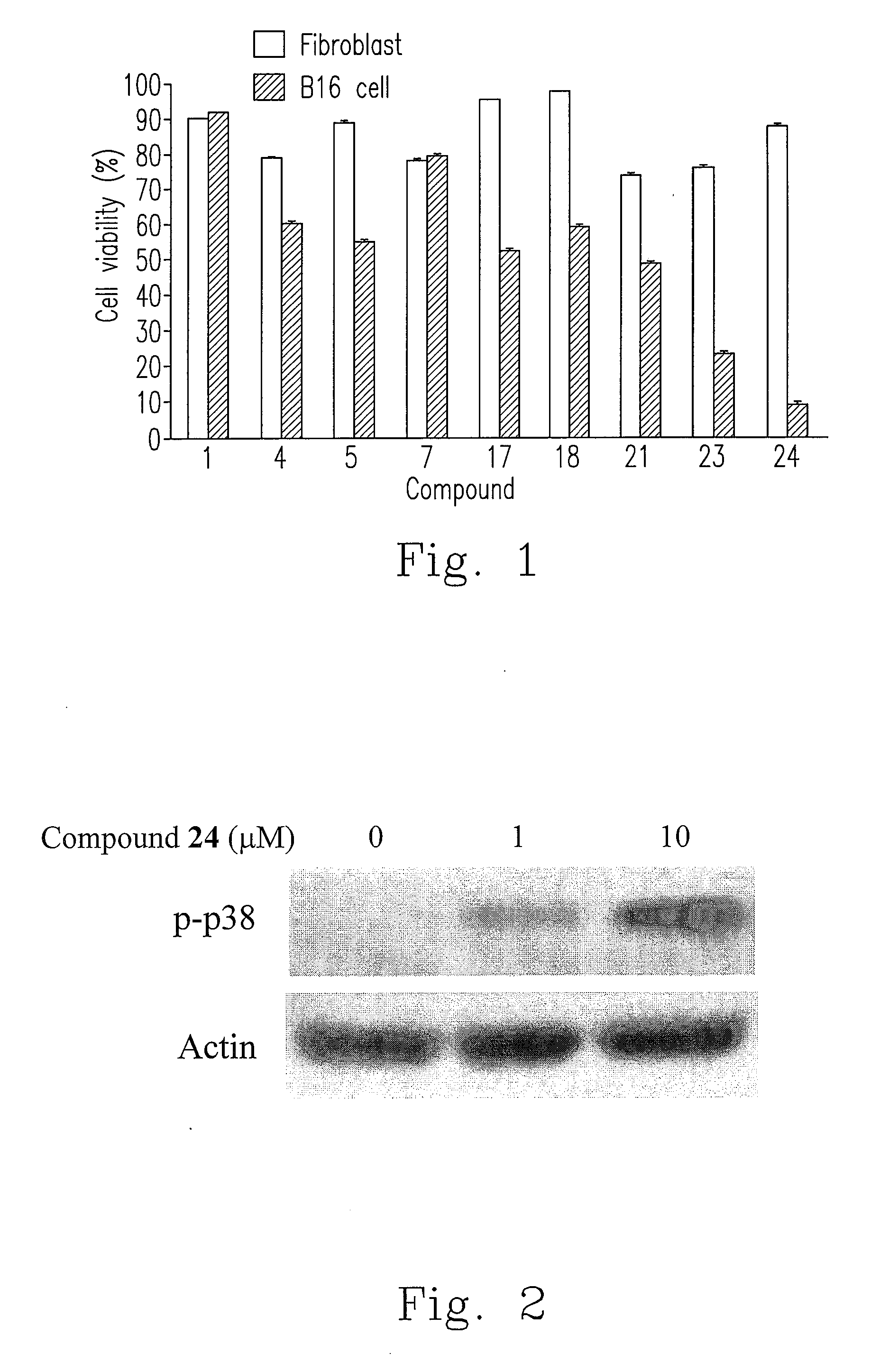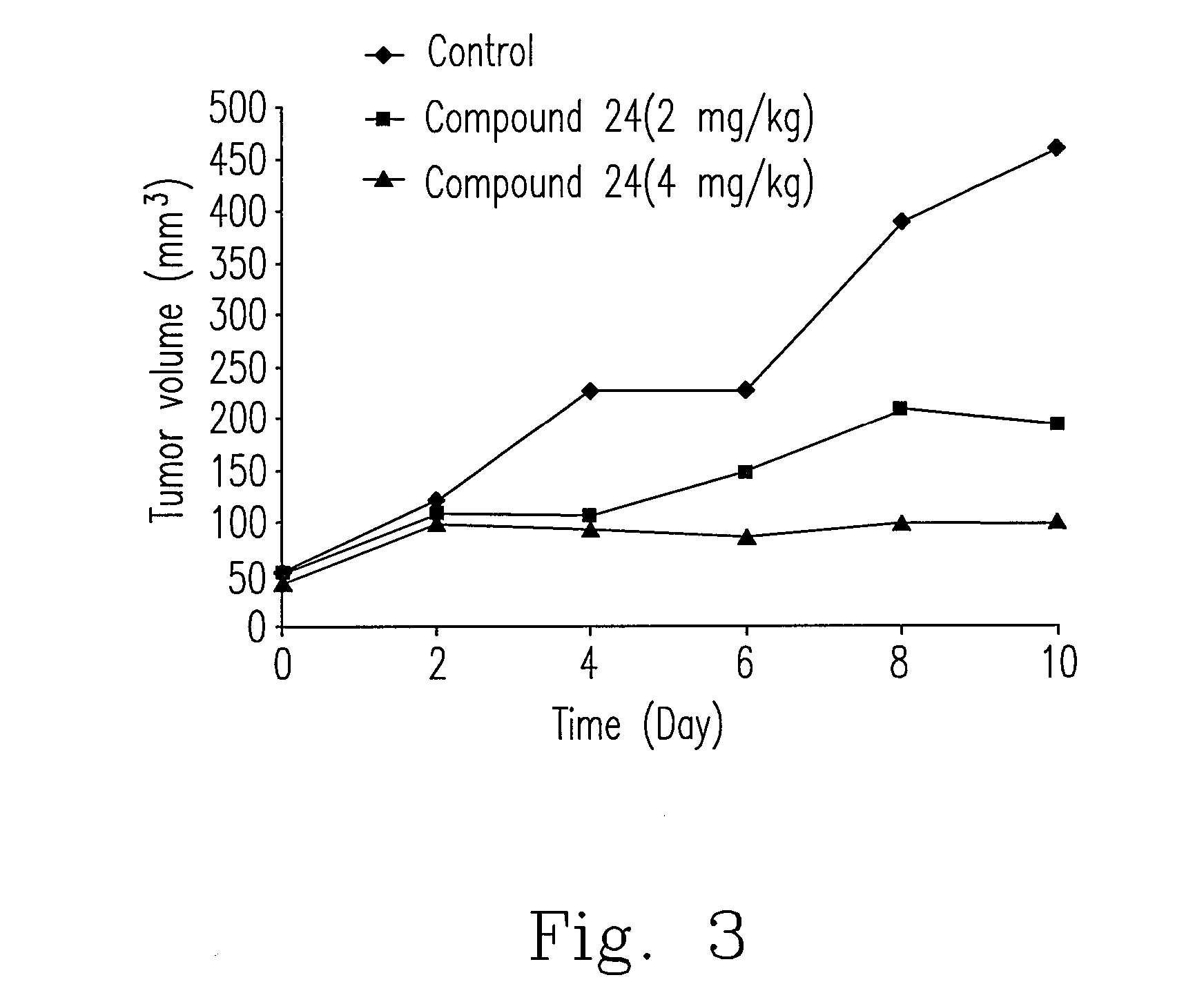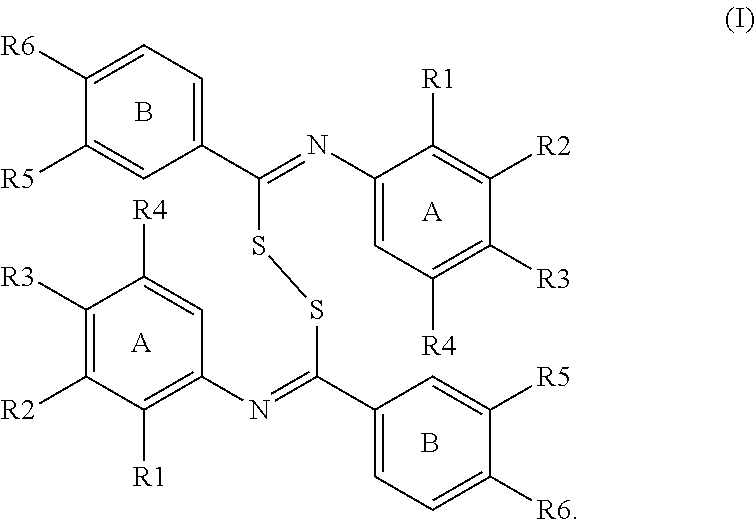Synthesis and antitumor activity of novel bis(benzylidene-benzenamine)disulfides
a technology of bis(benzene-benzenamine) and disulfide, which is applied in the preparation of isocyanic acid derivatives, drug compositions, organic chemistry, etc., can solve the problems of generating side effects, reducing the r&d of scientists, and destroying normal cells and tissues with chemotherapeutic drugs and high-energy radiation, etc., to achieve the effect of less susceptible, high reactivity and high raw material cos
- Summary
- Abstract
- Description
- Claims
- Application Information
AI Technical Summary
Benefits of technology
Problems solved by technology
Method used
Image
Examples
experiment 1
of bis(benzylidene-benzenamine)-disulfide
[0023]The key point of the invention is to synthesize bis(benzylidene-benzenamine)disulfide (hereinafter “disulfide”; formula III) having disulfide bond therein from two thiobenzamides (formula IV) using oxidizing reagent via the inter-molecular coupling reaction, which is represented as reaction formula I.
[0024]Each R7 respectively was bound to four neighboring carbon atoms of ring A. That is, each R7 sequentially was bound to para-carbon, meta-carbon, ortho-carbon and another para-carbon, and each R7 could be an electron-withdrawing group (EWG) or hydrogen (H). Furthermore, each R8 respectively was bound to ortho-carbon and meta-carbon of ring B, and each R8 could be an EWG, an electron-donating group (EDG) or H.
[0025]The oxidizing reagent of the invention could be 2,3-dichloro-5,6-dicyanobenzoquinone (DDQ), cerium(IV)ammonium nitrate (CAN), Dess-Martin periodinane (DMP), phenyliodine(III) bis(trifluoroacetate) (PIFA) or potassium ferricyan...
experiment 2
of Compounds to Cancer Cells
[0033]For confirming the cytotoxicity of bis(benzylidene-benzenamine)disulfides of the invention on various cancer cells, the well known MTT (3-(4,5-dimethylthiazol-2-yl)-2,5-diphenyltetrazolium bromide) colorimetric assay in this art was performed, and the method was not detailedly described herein. Please refer to Table 3, compound 12 was selected from compounds 1 to 24 to proceed cytotoxicity experiment. It could be known from Table 3 that the mean 50% growth inhibition (GI50) value for compound 12 was 0.372 μM, indicating that compound 12 has the potential for use as a highly potent broad-spectrum anticancer compound or reagent to inhibit the growth of a variety of cancer cell lines.
TABLE 3In vitro cytotoxicity of compound 12 in selected cancer cell linesCell lineGI50 (μM)Non-small cell lung cancerHOP-920.175NCI-H2260.427Colon cancerHCT-150.388Central nervous system cancerSNB-750.141MelanomaLOX MVI0.304MALME-3M0.252SK-MEL-50.262Ovarian cancerIGROV10.2...
experiment 3
Compounds to Cell Cycle
[0038]This experiment was performed by treating breast cancer cells MCF-7 with compounds, and then cell cycle was analyzed using flow cytometry known by the skilled person in the art. Firstly, breast cancer cells MCF-7 were treated with the prepared compounds (5 μM) for 24 hours and stained with propidium iodide (PI). Approximately 10000 cells from each sample were analyzed with FACScan flow cytometer and software. Data represented that the prepared compounds 4, 5, 7, 18, 21, 23 and 24 resulted in MCF-7 cells having a hypodiploid DNA content, indicating MCF-7 cells were arrested in sub-G1 phase. The sub-G1 DNA Peaks for compounds 4, 5, 7, 18, 21, 23 and 24 were 20.64%, 17.92%, 26.22%, 11.95%, 19.85%, 4.35% and 33.89% respectively (data not shown), while the sub-G1 DNA peak for control (without any drug treatment) was 11.54%.
PUM
| Property | Measurement | Unit |
|---|---|---|
| temperature | aaaaa | aaaaa |
| temperature | aaaaa | aaaaa |
| diameter | aaaaa | aaaaa |
Abstract
Description
Claims
Application Information
 Login to View More
Login to View More - R&D
- Intellectual Property
- Life Sciences
- Materials
- Tech Scout
- Unparalleled Data Quality
- Higher Quality Content
- 60% Fewer Hallucinations
Browse by: Latest US Patents, China's latest patents, Technical Efficacy Thesaurus, Application Domain, Technology Topic, Popular Technical Reports.
© 2025 PatSnap. All rights reserved.Legal|Privacy policy|Modern Slavery Act Transparency Statement|Sitemap|About US| Contact US: help@patsnap.com



